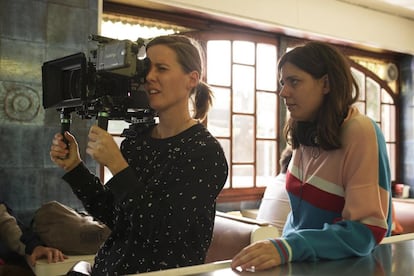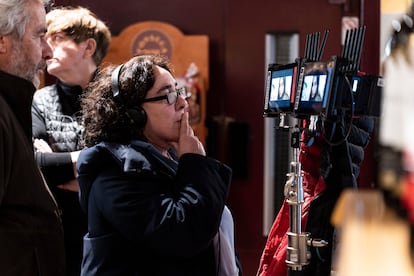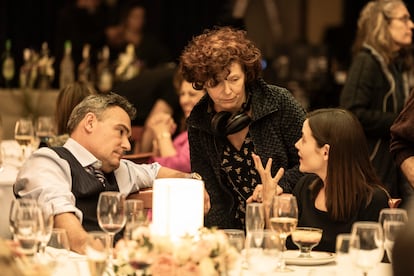“Equity levels could be reached soon, provided that the current trend is maintained or intensified.” For the first time, the annual CIMA report, the Spanish Association of Women’s Women and Audiovisual Media, on the female representation in the industry starts with optimism, yes, cautiously nuanced: “However, the representativeness of women still does not exceed 40% and the sector remains mostly masculinized (…). The representativeness of women in the sector of the feature film has increased from 26% in 2015 to 38% in 2015 to 38% in 2015 to 38% in 2015 to 38% in 2015 to 38% in 2015 to 38% in 2015 to 38% in 2015 to 38% 2023-2024 ”.
The presentation of the report, which analyzes the presence of women in Spanish feature films, has been this morning, coinciding with the celebration of Spanish Cinema Day, and as the first was in 2015, the authors of the study have reviewed the evolution of the female presence in the industry in almost a decade.
The analysis explains that the change has accelerated in the last five years: “The annual growth rate in terms of the presence of women has been faster in the last five years (4.7%), compared to the average of the last decade (4.2%). This fact is linked to the implementation of equality policies based on positive actions to counteract historical inequalities in this field, a greater visibility of women in the sector in the industry ”. And only if they are maintained, equity will be achieved, something attainable in two years, according to the data provided by the feature films that are recorded at the Institute of Cinematography and Audiovisual Arts (Icaa), an organism that governs the cinema within the Ministry of Culture, which are the basis of the study.
However, there is still a way: “Women usually concentrate on positions linked to aesthetics and organization (traditionally associated with female gender), while men occupy a greater diversity of roles, related to creativity, leadership and technologization (horizontal segregation). In addition, feminized positions or with equitable representation are usually located at the basis of the work structure They predominate at the upper levels, with greater power and decision -making capacity (vertical segregation). ”
For example, positions such as costume design and makeup and hairdressing “remain feminized, although with signs of slight descent.” For the study, “this can be interpreted as a possible advance towards equity, but also shows signs of stagnation or setback, according to the periods analyzed.” In 2024, costume teams have been led by 83% by women and makeup and hairdressing at 76%.
Improvements in male charges
In other positions, such as artistic management and production direction, “traditionally more equitable or even masculinized, relevant growth in women’s participation is detected.” If in the first one, “39% of women in 2017 to 68% in 2024” has been passed, the second, which in 2024 achieves 57% of women, is considered “equitable charge” because “it ranges between 40% and 59% of female representativeness.”
Positive changes are also noted in “historically masculinized positions, such as musical composition (26%in 2024), script (37%), special effects (35%) and sound (26%)”, because “they show annual growth rates greater than 10%, which suggests that they could reach equitable levels in less than a decade if the trend continues”.

There are two positions in Spanish cinema that have not improved in the last decade in the search for this equality: “In production there are no advances, remaining stagnant with a representativeness of women of 24% and a negative growth rate (annual average growth rate of -0.1% in the historical and of -4.5% in the last five years). Similarly, photography direction, although it has grown, it has grown, it is far from the parameters Equitative ”, because in 2024 it only reaches 21%. “The data shows an average net increase of 1.3%, which indicates that more than 14 years would be needed to enter equitable parameters.”
Cima emphasizes that in what baptizes as a management group (which combines production, direction and script) the resistance to change persists, “with lower growth rates compared to technical and artistic groups.” For the association, “this confirms a greater difficulty of access from women to leadership positions, where decision -making power is concentrated. The results range between percentages of 20% and 32%.”
In the interpretation, the association attracts attention in that “100% of the main roles are interpreted by people with senior identities (those of their biological sex), where CIS women represent 52.43% and Men CIS 43.82%. Non -hegemonic identities appear only in secondary roles and barely reach 0.60% representativeness”. And even that 52.43% hides a trap: “CIS women concentrate the prominence between the ages of 26 and 45. However, from the age of 46, it is the CIS men who occupy the centrality of the plot (70.27% of 46-50 years, 61.29% of the 51-55 years). With this, gender age is confirmed: as the age progresses, the central roles tend to masculinize. ”

In summary, “the low presence of diversity in management and script equipment is reflected in fictions: gender, ethnic-racial and regulations after the cameras translates into the same pattern on the screen, where non-hegemonic groups appear marginally, with little employability and limited representations.”
Where a deep gender gap is maintained in the budgets: films led by women go ahead with 24% less economic resources than those led by men. “The average costs of women led by women has been 1,707,559 euros, compared to 2,248,525 euros obtained on average by the feature films with male direction.” And that the greatest budget, less women lead the feature films.

Regarding the analysis of films that have received subsidies from the ICAA, “of the 433 feature films presented for state subsidies in 2024, 136 received financing. Of these, 40% were directed exclusively by women, 2% in mixed modality, and 58% by men. This reflects a significant participation of women after the direction, which, although it is not joint, enters into ranges of equitable distributions”. By the way, an optimistic fact in this chapter: “37% of financed feature films are scripted by women, 31% have mixed script and 32% are written exclusively by men.”
In return, the study warns about a possible trap to add points in subsidies: “According to the data reported by the ICAA, 87% of the feature films financed in 2024 have the executive production exclusively made by women, 13% in a mixed form and none only by men. Executive as an agglutinator of points that as a mechanism for correction of gender inequalities.
The gap on the platforms
There is still a battle for equity in a fundamental terrain: the platforms: “Most of the supported projects are led by men, both in the direction and in the script. Of a total of 45 feature films released, only 27% are directed by women, and only 16% were scripted by these. This reflects that, although the platforms open doors to new productions, they still reproduce male dynamics in the selection and support for projects (…).
The report concludes: “Although Spanish cinema advances towards more inclusive scenarios, full equality requires sustained and structural policies. It is recommended equitable, diverse and plural ”.

